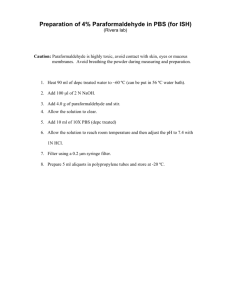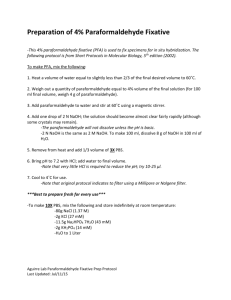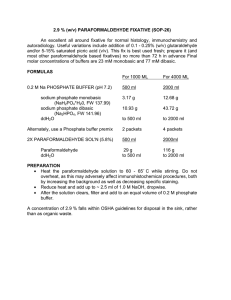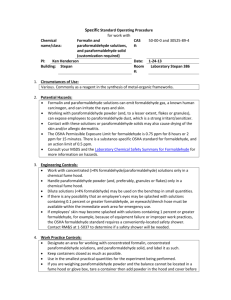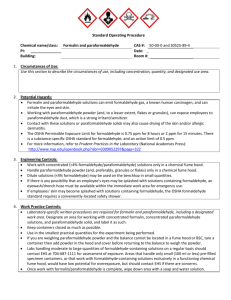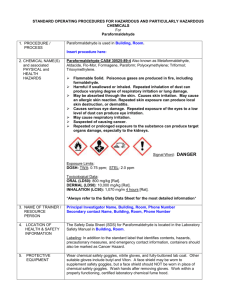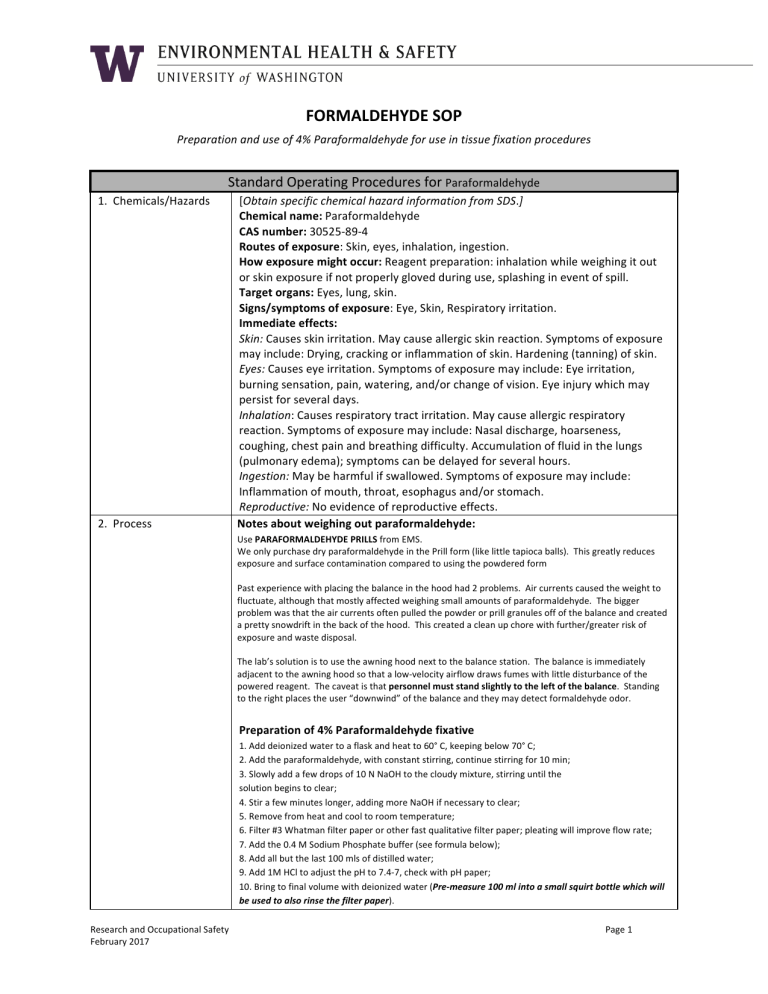
FORMALDEHYDE SOP Preparation and use of 4% Paraformaldehyde for use in tissue fixation procedures Standard Operating Procedures for Paraformaldehyde 1. Chemicals/Hazards 2. Process [Obtain specific chemical hazard information from SDS.] Chemical name: Paraformaldehyde CAS number: 30525-89-4 Routes of exposure: Skin, eyes, inhalation, ingestion. How exposure might occur: Reagent preparation: inhalation while weighing it out or skin exposure if not properly gloved during use, splashing in event of spill. Target organs: Eyes, lung, skin. Signs/symptoms of exposure: Eye, Skin, Respiratory irritation. Immediate effects: Skin: Causes skin irritation. May cause allergic skin reaction. Symptoms of exposure may include: Drying, cracking or inflammation of skin. Hardening (tanning) of skin. Eyes: Causes eye irritation. Symptoms of exposure may include: Eye irritation, burning sensation, pain, watering, and/or change of vision. Eye injury which may persist for several days. Inhalation: Causes respiratory tract irritation. May cause allergic respiratory reaction. Symptoms of exposure may include: Nasal discharge, hoarseness, coughing, chest pain and breathing difficulty. Accumulation of fluid in the lungs (pulmonary edema); symptoms can be delayed for several hours. Ingestion: May be harmful if swallowed. Symptoms of exposure may include: Inflammation of mouth, throat, esophagus and/or stomach. Reproductive: No evidence of reproductive effects. Notes about weighing out paraformaldehyde: Use PARAFORMALDEHYDE PRILLS from EMS. We only purchase dry paraformaldehyde in the Prill form (like little tapioca balls). This greatly reduces exposure and surface contamination compared to using the powdered form Past experience with placing the balance in the hood had 2 problems. Air currents caused the weight to fluctuate, although that mostly affected weighing small amounts of paraformaldehyde. The bigger problem was that the air currents often pulled the powder or prill granules off of the balance and created a pretty snowdrift in the back of the hood. This created a clean up chore with further/greater risk of exposure and waste disposal. The lab’s solution is to use the awning hood next to the balance station. The balance is immediately adjacent to the awning hood so that a low-velocity airflow draws fumes with little disturbance of the powered reagent. The caveat is that personnel must stand slightly to the left of the balance. Standing to the right places the user “downwind” of the balance and they may detect formaldehyde odor. Preparation of 4% Paraformaldehyde fixative 1. Add deionized water to a flask and heat to 60° C, keeping below 70° C; 2. Add the paraformaldehyde, with constant stirring, continue stirring for 10 min; 3. Slowly add a few drops of 10 N NaOH to the cloudy mixture, stirring until the solution begins to clear; 4. Stir a few minutes longer, adding more NaOH if necessary to clear; 5. Remove from heat and cool to room temperature; 6. Filter #3 Whatman filter paper or other fast qualitative filter paper; pleating will improve flow rate; 7. Add the 0.4 M Sodium Phosphate buffer (see formula below); 8. Add all but the last 100 mls of distilled water; 9. Add 1M HCl to adjust the pH to 7.4-7, check with pH paper; 10. Bring to final volume with deionized water (Pre-measure 100 ml into a small squirt bottle which will be used to also rinse the filter paper). Research and Occupational Safety February 2017 Page 1 Final Volume Paraformaldehyde Water Sodium Phosphate Buffer;0.4 M Stock;7.4-7.6 1L 2L 3L 40 g 750 mls 250 mls 80 g 1.5 L 500 mls 120 g 2.25 L 750 mls 3.8L (1gal) 152 g 2.85 L 950 mls Notes: • Paraformaldehyde will never appear to be dissolving until the NaOH is added. • Be patient, allow time for the NaOH to cause the paraformaldehyde to start dissolving before adding more. • There is always a little colloidal "fluff" in unfiltered para. • Don't weigh paraformaldehyde into plastic weigh boats - use a glass beaker to minimize static dispersion of paraformaldehyde dust. • Rinse out the filter paper in tap water before discarding, wash everything having contacted the paraformaldehyde. Lab Practices for handling 4% Paraformaldehyde: Our normal practices eliminate most of the need for double gloves. The dry reagent is always handled in a weighing container and liquid is transferred between containers. Fixed tissues are either washed with PBS before removal from the container in which they were fixed, or they are transferred with forceps, mesh container or spoon to a new container. Spills would be the exception for needing extra hand protections. 3. Planning and Preparation Hazardous chemical and specific SOP training will be provided to personnel working with Paraformaldehyde and any other personnel authorized or required to be in the laboratory during work with the chemical. Enter Paraformaldehyde into MyChem inventory, the online UW chemical inventory system. Attach SDS in the process. The SDS for Paraformaldehyde may be found in the lab MyChem inventory. Appropriate cleaning method(s) for Paraformaldehyde will be determined and supplies for cleaning and spill cleanup of Paraformaldehyde will be readily available. 4. Environmental/ Ventilation Controls Preparation of 4% Paraformaldehyde will be performed in a fume hood. • Exception: the paraformaldehyde is weighed out in Prill form using the balance that is next to the awning hood in CD186A. The balance is immediately adjacent to the awning hood that provides a low-velocity airflow to draw fumes with little disturbance of the powered reagent. The caveat is that personnel must stand slightly to the left of the balance. Standing to the right places the user “downwind” of the balance and they may detect formaldehyde odor. Use of 4% Paraformaldehyde fixative reagent: When working in the animal procedure room, 4% Paraformaldehyde fixative is used near the sink, which is equipped with a ventilation system. • Routine use of Paraformaldehyde outside of hood or exhausted containment is acceptable only when airborne formaldehyde levels have been monitored during the procedure by EH&S and found to be below the action level of 0.5 ppm. 5. Personal Protective Equipment (PPE) The following PPE will be worn when working with Paraformaldehyde: • Two pairs disposable nitrile exam gloves or one pair of thicker nitrile or butyl gloves (minimum 10 mil thickness) for concentrated chemical Our normal practices eliminate most of the need for double gloves. The dry reagent is always handled in a weighing container and liquid is transferred between containers. Fixed tissues are either washed with PBS before removal from the container in which they were fixed, or they are transferred with forceps, Research and Occupational Safety February 2017 Page 2 mesh container or spoon to a new container. Spills would be the exception for needing extra hand protections. • Disposable nitrile exam gloves for solutions • Safety glasses with side shields or chemical safety goggles • Lab coat or equivalent • If splash possible, wear face protection such as a face shield, and an impermeable apron with sleeves • Respiratory protection [if dust, aerosol or vapor hazard is present] Gloves will be changed immediately if contaminated, torn, or punctured. 6. Special Handling Procedures & Storage Requirements HANDLING Prep • All preparation of Paraformaldehyde solutions will be performed over plastic-backed absorbent pads in a fume hood. Pads will be disposed of after completion of tasks or immediately upon contamination. • Wear nitrile gloves for all procedures involving preparation and handling of Paraformaldehyde. • Change gloves after each use, or immediately when torn, punctured, or contaminated. [See preparation of 4% paraformaldehyde in Section 2.] Use • A sharps container will be in the immediate vicinity for safe sharps disposal. • If spills occur with powdered or liquid paraformaldehyde, the absorbent paper lining the hood bench will be removed, rinsed and disposed in accordance with this SOP. • All potentially contaminated disposable items will be placed in a waste bag before disposal. • Hands will be washed upon completion of tasks. STORAGE 1. Paraformaldehyde dry reagent will remain in its original plastic container. Solutions of formaldehyde will be stored in clearly labeled containers either in the under the hood or in the bottom shelf of the CD 186 refrigerator. TRANSPORT 2. 7. Spill and Accident Procedures [Specific cleaning and waste disposal procedures must be determined.] Paraformaldehyde will be transported in labeled and sealed non-breakable secondary containers. Paraformaldehyde spills must be cleaned up immediately by properly protected and trained personnel who are not sensitive to formaldehyde. All other persons should leave the area. Spill response procedures must be developed based on the chemical and potential spill or release conditions. Clean up spills using contents of the spill kit. Do not attempt to clean up any spill if not trained or comfortable. For large spills, evacuate the area and call 911* on campus phone for help. If spill is out of control, call 911*. If person injured, exposed, or suspected of being exposed to formaldehyde, follow procedures below in section 8. Exposure Procedures. * On UW Seattle campus call 911 on a campus phone; at medical centers and other locations follow internal emergency procedures. • Spills inside a fume hood, BSC, glove box or approved containment; and Research and Occupational Safety February 2017 Page 3 • Small Spills (250 ml or less) outside of fume hood or containment 1. Spills, regardless of size, inside a fume hood can typically be cleaned up by trained people who are not sensitive to formaldehyde. 2. Small spills outside a fume hood (250 ml or less) can also be managed by trained people who are not sensitive to formaldehyde. 3. Personnel must wear a lab coat or smock, safety goggles, two pairs of disposable nitrile exam gloves or one pair of thicker nitrile or butyl gloves (minimum 10 mil thickness) or Silver Shield gloves and shoe covers as needed when cleaning up spills. 4. Liquids: Wipe up spilled liquids with absorbent pads. If using a formaldehyde neutralizing absorbent, cover the spill with the absorbent and allow to set for the prescribed contact time (usually 15 min.), and then scoop up and dispose of properly. 5. Solids: Gently cover paraformaldehyde solid spills with wetted paper towels or absorbent pads to avoid raising dust and then wipe up. 6. Clean the spill area thoroughly with detergent solution followed by clean water. 7. If spill is extensive within the containment, clean all interior surfaces after completion of the spill cleanup. 8. Double bag all waste in plastic bags labeled with a hazardous waste label that reads "formaldehyde spill debris." Complete either an Online Chemical Waste Collection Request or a Chemical Collection Request Form (PDF). Email the form to chmwaste@uw.edu. • Large spills (greater than 250 ml) outside of fume hood or containment 1. Large formaldehyde spills (greater than 250 ml) outside a fume hood or containment may generate vapors above formaldehyde exposure limits; therefore, these spills require the use of respiratory protection. 2. Cover spill if possible to keep vapors down. 3. Evacuate area and restrict access. Attend to injured or exposed persons using emergency shower or eyewash. Follow procedures below in 8. Exposure Procedures. 4. As soon as possible report the spill in a safe area by notifying EH&S (during business hours (M-F/8-5) 206-543-0467, outside business hours 911* on a campus phone). Tell them that a spill has occurred, and you need help managing the spill. EH&S can arrange for a spill cleanup contractor. Notify supervisor. 5. Be prepared to provide the following information: • Name and phone number of knowledgeable person that can be contacted • Name of chemical spilled, concentration and amount spilled, liquid or solid type spill • Number of injured, if any (refer below to 8. Exposure Procedures in case of emergency) • Location of spill This information can also be used in reporting to the Emergency Research and Occupational Safety February 2017 Page 4 Department (ED) after potential exposure. 6. Only if staff are trained, have the proper PPE including respiratory protection and are comfortable with cleaning up the spill, they may proceed to clean it up. Personnel must wear a lab coat or smock, safety goggles, two pairs of disposable nitrile exam gloves or one pair of thicker nitrile or butyl gloves (minimum 10 mil thickness) or Silver Shield gloves, shoe covers, and a respirator specifically for protection against formaldehyde. Respirator use requires enrollment in UW’s respirator program. Contact EH&S at uwresp@uw.edu for information or see https://www.ehs.washington.edu/ohsresp/index.shtm. 7. Liquids: Wipe up spilled liquids with absorbent pads. If using a formaldehyde neutralizing absorbent, cover the spill with the absorbent and allow to sit for the prescribed contact time (usually 15 min.), and then scoop up and dispose of properly. 8. Solids: Gently cover paraformaldehyde solid spills with wetted paper towels or absorbent pads to avoid raising dust and then wipe up. 9. Clean the spill area thoroughly with detergent solution followed by clean water. 10. Double bag all waste in plastic bags labeled with a hazardous waste label that reads "formaldehyde spill debris.” Complete either an Online Chemical Waste Collection Request or a Chemical Collection Request Form (PDF). Email the form to chmwaste@uw.edu. Any spill incident requires the involved person or supervisor to complete and submit the Online Accident Reporting System (OARS) form to EH&S within 24 hours (8 hours if serious injury or hospitalization). For questions on spill cleanup, contact EH&S spill consultants at 206-543-0467. 8. Exposure Procedures In Case of Emergency * On UW Seattle campus call 911 on a campus phone; at medical centers and other locations follow internal emergency procedures. 1. Provide First Aid Immediately • For sharps injury (needlestick or subcutaneous exposure), scrub exposed area thoroughly for 15 minutes using warm water and sudsing soap. 2. 3. Research and Occupational Safety February 2017 • For skin exposure, use the nearest safety shower for 15 minutes. Stay under the shower and remove clothing. Use a clean lab coat or spare clothing for cover-up. • For eye exposure, use the eyewash for 15 minutes while holding eyelids open. • For inhalation exposure, move out of contaminated area. Get medical help. Get Help • Call 911* on campus phone or go to nearest Emergency Department (ED). Give details of exposure, i.e. chemical, dose, route of exposure, time since exposure. Bring to the ED the SDS and this SOP. • Notify your supervisor as soon as possible for assistance. • Secure area before leaving. Report Incident to Environmental Health & Safety • During business hours (M-F/8-5) call 206-543-7262. • Outside business hours call 206-685-UWPD (8973) or 911* to be routed to EH&S staff on call. • If serious accident, hospitalization or fatality, notify EH&S immediately Page 5 after providing first aid and/or getting help. • 9. Waste Collection and Disposal Waste Formaldehyde Treatment (if applicable) For all incidents and near misses, the involved person or supervisor completes and submits the UW Online Accident Reporting System (OARS) form to EH&S within 24 hours (8 hours if serious injury or hospitalization). * On UW Seattle campus call 911 on a campus phone; at medical centers and other locations follow internal emergency procedures. Collection • Waste formaldehyde-containing chemical is considered a hazardous chemical waste. • Accumulate waste in a sturdy, chemically compatible container with a secure closure. For contaminated debris, a bag may be used, but it must be strong enough to prevent the contents from puncturing through. • Double bag all used and contaminated (not grossly contaminated) disposable items, such as gloves, paper towels and absorbent pads, in plastic bags. Label as non-hazardous waste before disposing in the trash. • Place grossly contaminated disposable items in double plastic bags for hazardous waste pickup. • All waste containers must be properly labeled with all of the contents. • All waste containers must be properly closed or sealed. • Waste formaldehyde-containing solutions with specimens or tissue samples must be separated before disposal. The specimens may be considered biohazardous waste, which would need to be handled according to procedures given at http://www.ehs.washington.edu/ohsreslab/biowaste.shtm Disposal • • For waste pickup: Complete either an Online Chemical Waste Collection Request or a Chemical Waste Collection Request Form (PDF). Email the form to chmwaste@uw.edu. Contact EH&S Environmental Programs Office at 206-616-5835 or email chmwaste@uw.edu for waste disposal guidance and instructions. Waste Formaldehyde Treatment [Describe waste formaldehyde treatment procedure if applicable. Contact EH&S Environmental Programs Office at 206-616-5835 or chmwaste@uw.edu for waste treatment procedures and questions.] 10. Special Precautions for Use of Paraformaldehyde in Animals (if applicable) Use of Paraformaldehyde in animals will be documented and approved by IACUC. P N/A Particularly hazardous substance involved? X YES: NO: Blocks #11 to #13 are Mandatory Blocks #11 to #13 are Optional. 11. Approval Required All staff working with Paraformaldehyde must be trained on this SOP prior to starting work. They must also be trained on the Paraformaldehyde SDS, and it must be readily accessible in the laboratory. All training must be documented and maintained by the PI or their designee. 12. Decontamination All surfaces will be decontaminated with a solution of detergent and water after removing the plastic backed pads. Research and Occupational Safety February 2017 Page 6 13. Designated Area All work with Paraformaldehyde must be done in a designated laboratory, work space, and hood or ventilated area. This work will be conducted in CD186A and CD055. Name: Robin Gibson Title: Lab Manager Signature: Date: 3/16/2017 Dr.s Edwin W Rubel and Jennifer Stone (PI’s); Research and Occupational Safety February 2017 Title: Professors Page 7 [Laboratory Name] Documentation of Training Standard Operating Procedure for Paraformaldehyde Name SOP Training Date Click here to enter name. Click here to enter date. Click here to enter name. Click here to enter date. Click here to enter name. Click here to enter date. Click here to enter name. Click here to enter date. Click here to enter name. Click here to enter date. Click here to enter name. Click here to enter date. Click here to enter name. Click here to enter date. Click here to enter name. Click here to enter date. Click here to enter name. Click here to enter date. Click here to enter name. Click here to enter date. Click here to enter name. Click here to enter date. Click here to enter name. Click here to enter date. Click here to enter name. Click here to enter date. Click here to enter name. Click here to enter date. Click here to enter name. Click here to enter date. EH&S Research and Occupational Safety February 2017 Signature
